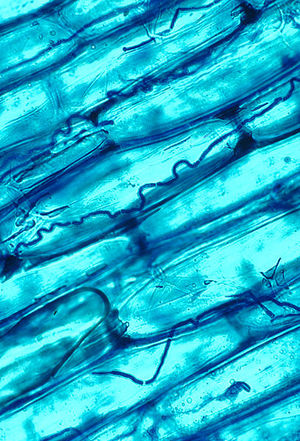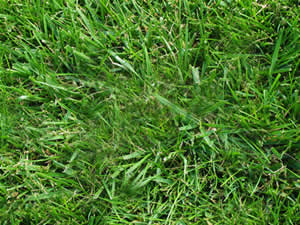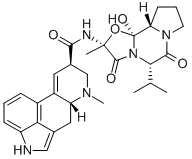Neotyphodium coenophialum
A Microbial Biorealm page on the genus Neotyphodium coenophialum

Classification
Higher order taxa
Kingdom Fungi; Division Ascomycota; Class Ascomycetes; Subclass Sordariomycetes; Order Hypocreales; Family Clavicipitaceae
Species
Neotyphodium coenophialum
|
NCBI: Taxonomy |
Description and significance
Neotyphodium coenophialum is the anamorph of the endophyte fungus Epichloë typhina. It was previously known as Acremonium coenophialum. N. coenophialum associates with pooid type grasses (wheat, rye, turf grass, etc) and exhibits a Type III Acremonium – grass association. This type of interaction is mutualistic and aids in the distribution of the fungus while granting many varied benefits to the host plant. Among these benefits is the production of various alkaloid compounds. These compounds act a deterrent to herbivorous ruminant species and cause disease when ingested. Within the agricultural community this leads to loss of production through crop infection, poor animal output (milk, meat, etc), and animal death.
Cell structure and metabolism
As a member of the Kingdom Fungi, N. coenophialum is a eukaryotic organism and as such consist of many cells that are surrounded by cellular membranes composed of a lipid bilayer. It undergoes mitosis (since it is an anamorph fungal form) to reproduce and is only transmitted vertically through plant populations. In order to reproduce utilizing a type III system, the endophyte must infect the seed of the plant. To do this, the mycelia present on the host plant infect the meristematic cells (the cells that give rise to various parts of the plant, much like stem cells in mammals) of the developing seed. These mycelia continue to propagate through the seed as it develops and will finally infect the embryo once all separate parts of the plant have been distinguished. Once the seeds germinate, mycelia are present throughout the majority of the plant except for the root system. This is thought to be because of the higher amount of sugar and thus, nutrient content, available in the greener parts of the grass. Once the plant has begun to develop, the endophyte present within it will be an identical replica of the endophyte found in the original host plant. However, in some cases, mycelia may not have a chance to infect developing seeds and therefore some offspring of certain grass plants will develop and grow without the endophyte infection.
The endophyte utilizes the sugars within the plant, such as sucrose, as a main nutrient and secrete sugar alcohols as a by-product. These alcohols can then be readily used again by the plant, one form of the mutualistic interaction that the fungus and its host plant display.
Ecology
N. coenophialum associates with pooid type grasses and exhibits a Type III Acremonium – grass association. Each interaction system is based upon whether or not stromata occur in each type of infection. Stromata are groups of mycelia that form on the plant stalk to form a base on which reproductive structures can form. In a type III interaction, stromata are not formed at all on an infected plant, instead, the fungus infects the embryo of the seed of the plant and develops as the plant itself develops. With a lack of stromata formation, no damage occurs to the plant and therefore this type of endophyte cannot be considered a true plant pathogen. The only effect arising from this type of association is that the plant develops more slowly when compared to a non-infected plant of the same type.

N. coenophialum endophytes are shown to be in a mutualistic relationship with their host plants. This is shown by the idea that an endophyte that only reproduces vertically through the maternal host seeds will not survive within the host population. This is true because a parasitic endophyte that harms and eventually kills its host seeds will lose any viable hosts available while normal, uninfected hosts generate healthy seeds that will eventually outperform the endophyte infected plants. In this sense, N. coenophialum must be mutualistic in order to continue propagation within its host range. Some of the mutualistic effects given to the host plants are alkaloids that serve as an anti-herbivore chemicals, protection against other fungal pathogens, protection against arthropod borne pathogens, drought resistance, increased productivity (separate from slow growth and assuming necessary nutrients are available), and enhanced photosynthetic rates.
N. coenophialum gives protection against other fungal pathogens as the higher the level of endophyte present within the host, the less likely the seedlings produced were to die from other pathogens like Rhizoctonia zeae or Puccinia coronata. This is also true of arthropod borne infections such as barley yellow dwarf virus.
Drought tolerance is another advantage that may be given to a host plant with a N. coenophialum infection. Two reasons for this advantage may be because of altered plant physiology and altered plant chemical compounds. Endophyte infection has the possibility to affect the osmotic balance of the plant and the plant’s stomata operation. This combination may lead to a higher stability within the plant tissues that prevents wilting under conditions of water loss. Furthermore, the creation of alkaloid compounds may also change the osmotic balance of the plant and provide the same type of advantage.
N. coenophialum also offers some growth advantages. While the endophyte slows the actual rate of growth of the plant, it does increase the productivity of the plant and may increase photosensitivity rates under conditions of high nutrient availability. For example, when the endophyte utilizes the sucrose available in their plant hosts for nutrtion and secrete sugar alcohols as a by-product, the lack of sucrose prevents the inhibition of photosynthesis (feedback loop), which in turn increases photosynthesis and increases plant growth. This does have some limitations however as the plant can perform poorly under conditions of very poor nutrient availability.
The final advantage given to host grasses is the production of alkaloids by the endophyte. Alkaloids provide a defense against herbivorous predators like cattle or other ruminants. The four different types of alkaloids present in N. coenophialum are ergovaline, loline alkaloids, and peramine. Each alkaloid uses a different chemical mechanism to deter predators and each can cause its own array of symptoms. Ergovaline is the most commonly produced alkaloid the most likely to cause disease within herbivorous animals.
Pathology
Ergovaline is a heterocyclic chemical compound similar to ergotamine, the toxin found in ergot infected wheat. Its main toxicity comes causing a vasoconstrictive reaction that impedes circulation. On a larger level, ergovaline causes a condition known as fescue toxicosis. It affects several systems in the body including the cardiovascular system and the nervous system and can also accumulate in adipose fat tissue. It has a half life of 20-30 minutes and is processed by the liver enzyme subfamily cytochrome P450 3A for excretion. Ergovaline acts as an antagonist for several hormones present within an animal. It is a dopamine D1 agonist, a dopamine D2 agonist, and a serotonergic2 receptor agonist. As a dopamine D1 agonist, ergovaline is responsible for the vasoconstriction seen throughout the body. As a dopamine D2 agonist, ergovaline inhibits prolactin secretion from the anterior pituitary which in turn disrupts the endocrine system as a whole. Among these disruptions caused by lack of prolactin is the loss of production of milk in lactating animals, the loss of corpus luteum function, and the loss of gonadotropin secretion. These conditions combined can lead to defects throughout the reproductive cycle including lack of necessary hormones and abortion. It is critically important that pregnant or nursing animals not be exposed to the fungal endophyte producing ergovaline.

In cattle, ergovaline causes a type a fescue toxicosis that is nicknamed “summer slump.” It is a condition of poor performance, usually seen in the hotter times of the year (most likely due to increased endophyte production during these times) that occurs in cattle that have ingested fescue grass infected with N. coenophialum. The most common symptoms are the retaining of the winter hair coat and lack of gain from feed. The lack of gain can be explained by the cattle having a higher body temperature due to the vasoconstriction that occurs as a result of the ergovaline acting as the dopamine D2 antagonist. This vasoconstriction prevents the dilation of blood vessels near the surface of the skin which causes the animals to retain heat instead of losing it through passing air currents. This buildup of heat causes the animals to seek shelter in shady areas and remain there in an attempt to cool off instead of following their usual grazing patterns. This lack of grazing is what ultimately leads to the poor performance in the afflicted cattle. Additionally, symptoms relating to milk production and conception occur as well. Since the presence of the endophyte has the ability to disrupt the hormonal balances of the animal, including those needed for milk production, calves get around 50% less milk from their infected dams, leading to an unthrifty appearance in the calves. The hormone imbalance affects conception since the hormones needed (estrogen and progesterone) are out of sync. Without the proper balance, there is no way for the dam to carry her calf to term, ultimately leading to an aborted calf.
A second affliction of cattle that results from fescue toxicosis is a condition called “fescue foot.” The main cause of this condition lies within the vasoconstrictive properties that the alkaloid produces. Cattle that have consumed the infected plants develop issues within the vasculature of their hooves and legs. In large cloven hoofed animals, adequate blood flow is absolutely necessary for health in the legs. If this is not achieved, problems like laminitis can develop and lameness will occur. Any herd type animal that becomes lame is more subject to predation and death. In fescue foot, blood flow is less than adequate due to vasoconstriction that occurs in the coronary band of the hoof and the fetlock of the leg. This lack of blood flow can lead to gangrenous types of infection in the hooves which can eventually lead to the hoof sloughing off. This is an incredibly painful condition as evidenced by the postures that cattle take to avoid the pressure being placed on their hooves and legs.
The third condition that ergovaline alkaloid toxicity causes is called lipomatosis, or the necrosis of fat stores within mature cattle. Depending on where the condition is occurring within the cattle determines what types of symptoms are seen. If lipomatosis is occurring in the fat stores around the gastro-intestinal tract then issues can occur that involve bloat or intestinal obstruction. If lipomatosis occurs around the pelvic area, problems involving dystocia can occur.
Small ruminants can also experience problems with fescue toxicosis. Sheep are especially susceptible and show signs of toxicosis very similar to those of cattle. However, they can also develop necrosis of the tongue that associates with infertility at the same time. Lipomatosis has also been reported to have occurred in small ungulate species like deer and goats who present with fescue toxicosis caused by N. coenophialum.
Among horses, the most common issue resulting from fescue toxicosis is reproductive problems stemming from the dopamine D2 antagonistic effects. Horses do not abort their pregnancies like the other herbivores do and are actually much less likely to suffer from any symptoms early in the pregnancy. However, if the mare is turned out to infected fescue pasture after the 300th day of her pregnancy, the foal she carries can begin to develop improperly. The affects seen in the mares consist of late-running pregnancies (up to a month of additional pregnancy time) and agalactica. With foals that are born from a mare that has ingested endophyte infected fescue, there are usually two outcomes. The first outcome is a normal sized or smaller than average foal that is called a “dummy foal.” The nickname stems from the fact that the foal will have a lack of mental ability that prevents learning to nurse and late development. The second outcome results in a foal that is similar to the “dummy foal,” but has overmatured. The over-development is a product of the mare carrying the foal for an extra month of pregnancy combined with the degenerative affects of the endophyte. For the foal, along with being larger, this means overly large hooves and pre-erupted teeth that are likely to cause damage to the mother’s teats during nursing. For the mare, the larger foal can cause dystocia resulting from a birth canal that isn’t prepared for such large offspring. This dystocia can tears and lacerations within the uterus and vagina that can lead to infection, bleeding out, and death for the mare.
References
White, J. F., Jr., G. Morgan-Jones, and A. C. Morrow. "Taxonomy, Life Cycle, Reproduction and Detection of Acremonium Endophytes." Agriculture, Ecosystems & Environment 44.1-4 (1993): 13-37. Print.
"stroma". Encyclopædia Britannica. Encyclopædia Britannica Online. Encyclopædia Britannica Inc., 2012. Web. 28 Nov. 2012
"Poaceae". Encyclopædia Britannica. Encyclopædia Britannica Online. Encyclopædia Britannica Inc., 2012. Web. 28 Nov. 2012
Clay, Keith, and Christopher Schardl. "Evolutionary Origins and Ecological Consequences of Endophyte Symbiosis with Grasses." The American Naturalist 160.S4 (2002): S99-127. Print.
Gwinn, K. D., and A. M. Gavin. "Relationship between Endophyte Infestation Level of Tall Fescue Seed Lots and Rhizoctonia Zeae Seedling Disease." Plant Disease 76 (1992): 911-14. Print.
Ford, V. L., and T. L. Kirkpatrick. "Effects of Acremonium coenophialum in Tall Fescue on Host Disease and Insect Resistance and Allelopathy to Pinus taeda Seedlings." Proceedings of the Arkansas Fescue Toxicosis Conference 140 (1989): 29-34. Print.
Mahmood, T., R. C. Gergerich, E. A. Milus, C. P. West, and C. J. D'Arcy. "Barley Yellow Dwarf Viruses in Wheat, Endophyte-Infected and Endophyte-Free Tall Fescue, and Other Hosts in Arkansas." Plant Disease 77.3 (1993): 225-28. Print.
"Ergovaline." PubChem. N.p., n.d. Web. 29 Nov. 2012. <http://pubchem.ncbi.nlm.nih.gov/summary/summary.cgi?cid=104843>.
Gupta, Ramesh C. Veterinary Toxicology: Basic and Clinical Principles. Amsterdam [etc.: Elsevier [etc., 2012. Print.
Shelby, Richard A., Roger C. Bridgman, Forrest T. Smith, and Venkatram R. Atigadda. "Determination of Ergovaline in Tall Fescue by a Specific Monoclonal Antibody." Food and Agricultural Immunology 10.4 (1998): 339-47. Print.
Washburn, Brian E., Thomas G. Barnes, and Jeffrey D. Sole. "Improving Northern Bobwhite Habitat by Converting Tall Fescue Fields to Native Warm-Season Grasses." Wildlife Society Bulletin 28.1 (2000): 97-104. Print.
Ruffner, Marvin E., and Thomas G. Barnes. "Natural Grassland Response to Herbicides and Application Timing for Selective Control of Tall Fescue, an Invasive Cool-Season Grass." Invasive Plant Science and Management 3.3 (2010): 219-28. Print.
Rudgers, Jennifer A., Susan Fischer, and Keith Clay. "Managing Plant Symbiosis: Fungal Endophyte Genotype Alters Plant Community Composition." Journal of Applied Ecology 47.2 (2010): 468-77. Print.
http://www.ars.usda.gov/is/graphics/photos/jul00/k8931-2.htm
http://www.tecology.it/eng/tecology_manti_erbosi/tecology_microterme.html
